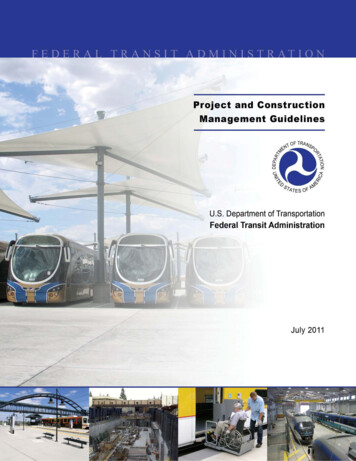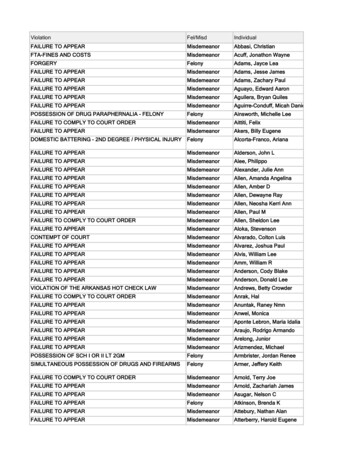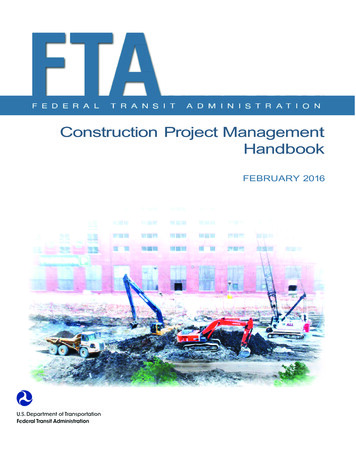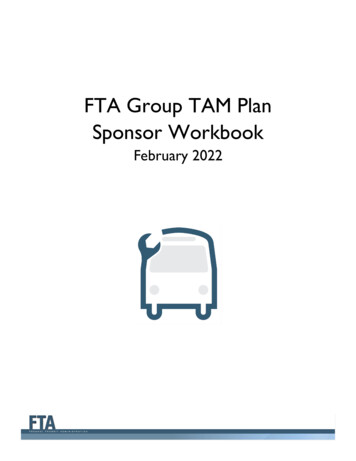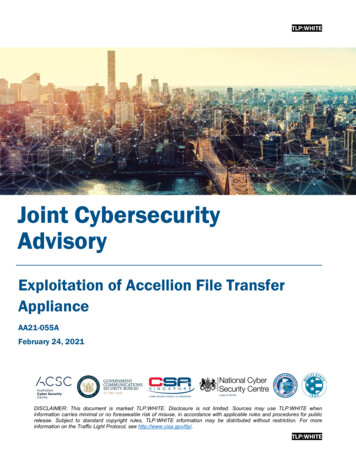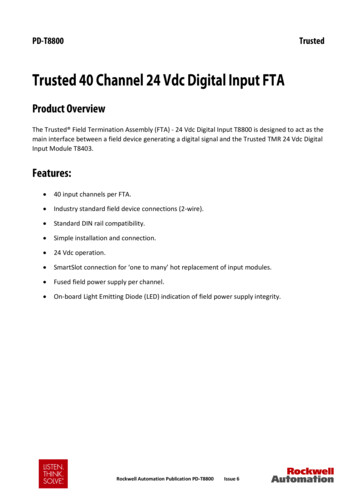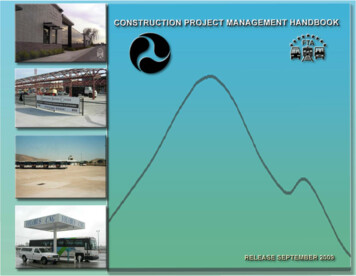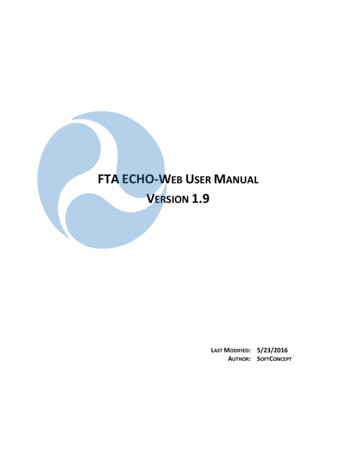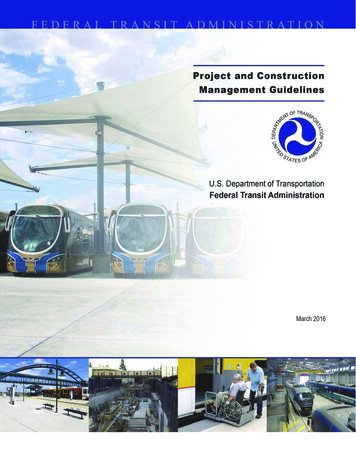
Transcription
' '::\I:·I ' ' I :' :". .I· I :'I,Project and ConstructionManagement GuidelinesU.S. Department of TransportationFederal Transit AdministrationMarch 2016
NOTICEThis document is disseminated under the sponsorship of the Department of Transportation inthe interest of information exchange. The United States Government assumes no liability forits contents or use thereof.The United States Government does not endorse products or manufacturers. Trade ormanufacturers' names appear herein solely because they are considered essential to theobject of this report.
Technical Report Documentation PageForm Approved OMB No. 0704-0188Public reporting burden for this collection of information is estimated to average 1 hour per response, including the timefor reviewing instructions, searching existing data sources, gathering and maintaining the data needed, and completingand reviewing the collection of information. Send comments regarding this burden estimate or any other aspect of thiscollection of information, including suggestions for reducing this burden, to Washington Headquarters Services,Directorate for Information Operations and Reports, 1215 Jefferson Davis Highway, Suite 1204, Arlington, VA 222024302, and to the Office of Management and Budget, Paperwork Reduction Project (0704-0188), Washington, DC 20503.1. AGENCY USE ONLY (Leave2. REPORT DATE February 20163. REPORT TYPE AND DATESblank)Original September 1990Updates June 1996, May 2003,July 2011 and March 20164. TITLE AND SUBTITLE5. PROJECT ID NUMBERProject and Construction Management Guidelines: March 20166. AUTHOR(S)* Kam Shadan, lead author for this update, with supportWilliam Plumpton (Gannett Fleming), Michael Eidlin (Kal KrishnanConsulting Services), David Sillars (Sillars), Paul Krogh (K2 ConstructionConsultants), Dain Pankratz (Boyd Caton & Grant), and Robin Hazy (RaulV. Bravo Associates)7. PERFORMING ORGANIZATION NAME(S) AND ADDRESS(ES)8. PERFORMING ORGANIZATIONGannett Fleming, Inc.REPORT NUMBERSan Bruno Office Park881 Sneath Lane, Suite 210San Bruno, California 940669. SPONSORING/MONITORING AGENCY NAME(S) AND10. SPONSORING/MONITORINGADDRESS(ES)AGENCY REPORT NUMBERU.S. Department of TransportationFederal Transit Administration1200 New Jersey Avenue, S.E.Washington, DC 2059011. SUPPLEMENTARY NOTES * Assisted by: Lee Hamre (H.C. Peck & Associates), and Kate Berrigan (GannettFleming)12a. DISTRIBUTION/AVAILABILITY STATEMENT12b. DISTRIBUTION CODEAvailable online at http://www.fta.dot.gov13. ABSTRACT (Maximum 200 words) This update of the document published in September 1990 and updated in June1996, May 2003, and July 2011 reflects FTA project development, grants, and project management requirements. Itincorporates the experience of FTA’s Project Management Oversight Program research and technical assistanceinitiatives, and new or updated Circulars and legislation, including changes due to the Moving Ahead for Progress in the21st Century Act. Additional guidance is provided on safety and security considerations and certification process,project risk assessment and allocation, project controls, project delivery approaches, financing, real estate acquisition,dispute resolution, quality assurance/quality control, value engineering, public communications, and identifies additionalsources of guidance, training, and assistance.The Guidelines describe the transit capital project development process, general project management principles, and theapplication of those principles in the planning, design, construction/equipment procurement, and testing/start-up phases.While emphasizing Major Capital Projects and New Starts projects, information on the Small Starts program is alsoprovided. Regardless, the principles and practice discussed have applicability to any capital transit project.14. SUBJECT TERMS Transit Capital Projects, Project Management,15. NUMBER OF PAGES 341Construction Management, Project Control Project Planning, Finance, Risk16. PRICE CODEAssessment Quality Assurance Quality Control, Safety and SecurityManagement Plan Safety Certification Design/Build, Real Estate Acquisition17. SECURITY18. SECURITY19. SECURITY20. LIMITATION OFABSTRACT: NoneCLASSIFICATION OFCLASSIFICATION OFCLASSIFICATION OFREPORTTHIS PAGEABSTRACTUnclassifiedUnclassifiedUnclassified
ACKNOWLEDGEMENTSThe 2016 Project and Construction Management Guidelines Update project wassponsored and managed by FTA’s Office of Engineering led by Chris Nutakor and DaleWegner. The lead author for this Guidelines update was Kam Shadan, P.E., VicePresident of Gannett Fleming, Inc., a national engineering and construction managementfirm with specialized expertise in transit project planning, design, and construction.Additional specialized inputs were provided by William Plumpton (Gannett Fleming),Michael Eidlin (Kal Krishnan Consulting Services), David Sillars (Sillars), Paul Krogh (K2Construction Consultants), Dain Pankratz (Boyd Caton & Grant), Robin Hazy (Raul V.Bravo Associates) and Lee Hamre (H.C. Peck & Associates), and most particularly KateBerrigan (Gannett Fleming), Chief Editor.Throughout this update, FTA’s Dale Wegner provided direction on content modifications.Selected FTA subject matter experts were asked to review various sections of the initialdraft of the Guidelines and offer comments, and did so to varying degree with commentstaken into consideration.FTA Project and Construction Management GuidelinesMarch 2016 UpdatePage i
TABLE OF CONTENTSACKNOWLEDGEMENTS . iTABLE OF CONTENTS. iiLIST OF FIGURES. viiiLIST OF TABLES . viiiLIST OF ACRONYMS. ixChapter 1 INTRODUCTION . 1-11.11.21.3Purpose and Scope of the Guidelines .1-1Reasons for the Guidelines Update . 1-2Format and Content Summary . 1-3Chapter 2 – TRANSIT CAPITAL PROJECT DEVELOPMENT PROCESS . 2-12.12.2Overview . 2-12.1.1 Major Capital Projects . 2-22.1.1.1 Automatic Pre-Award Authority and Letters of No Prejudice. 2-52.1.2 Capital Projects Not Classified as Major Capital Projects . 2-72.1.2.1 Transit Asset Management Practices . 2-82.1.2.2 Bus Maintenance Facilities . 2-82.1.2.3 Vehicle Procurements. 2-82.1.2.3.1Transit Vehicles Procurement: .2-102.1.2.3.2Regulatory References .2-102.1.2.3.3Vehicle Procurement Deliverables .2-112.1.2.3.4Buy America Requirements for Revenue Service Vehicles .2-132.1.2.3.5Pre-Award Audit Requirements .2-142.1.2.3.6Post Delivery Audit Requirements.2-162.1.2.4 Multimodal Transfer Facilities . 2-162.1.2.5 Bus Rapid Transit (BRT) Projects . 2-162.1.2.6 New Technology Procurements . 2-17Project Development Elements of Sound Transportation Planning . 2-172.2.1 Systems Planning . 2-172.2.2 Alternatives Analysis . 2-202.2.3 Project Management Plan (PMP) . 2-212.2.4 Rail Modernization Planning . 2-252.2.5 Bus Maintenance Facility Planning . 2-272.2.6 Project Risk Analysis and Procurement Planning . 2-272.2.7 Environmental Planning . 2-322.2.7.1 Scoping . 2-352.2.7.2 FTA’s Expanded Use for Categorical Exclusions . 2-362.2.7.3 Section 4(f) of the U.S. Department of Transportation Act of 1966 . 2-372.2.7.4 The National Historic Preservation Act of 1966 . 2-402.2.7.5 FTA’s Environmental Justice Policy Guidance . 2-412.2.7.6 MAP-21 and Changes to the Environmental Review Process . 2-422.2.7.7 FTA Guidance on Corridor Preservation . 2-44FTA Project and Construction Management GuidelinesMarch 2016 UpdatePage ii
Table of Contents2.2.82.2.92.3Financial Planning . 2-45FFGA and Other Grant Requirements . 2-472.2.9.1 Full Funding Grant Agreement (FFGA) . 2-472.2.9.2 Other Requirements . 2-472.2.10 Joint Development Planning/Coordination with Transit Project Planning . 2-482.2.11 Safety and Security Management Plan (SSMP) . 2-502.2.11.1 Introduction and Background to the SSMP . 2-502.2.11.2 Authority for and Elements of an SSMP .2-512.2.11.3 SSMP Content . 2-532.2.11.4 Safety and Security Considerations When An SSMP Is Not Required . 2-552.2.11.5 State Safety Oversight Agency Considerations. 2-55Engineering and Design . 2-562.3.1 Definition of Sufficient Level of Engineering . 2-562.3.2 Project Development (PD) . 2-572.3.3 Engineering Phase . 2-642.3.4 Construction And Equipment/Materials Procurement Phase . 2-662.3.5 Recovery Plan .2-672.3.6 Testing and Start-Up Phase . 2-672.3.7 Revenue Service Phase . 2-682.3.7.1 Operation and Maintenance . 2-682.3.7.2 System Performance Monitoring/Assessment. 2-682.3.7.3 Before and After Study . 2-692.3.7.4 Capital Replacement Planning . 2-702.3.7.5 State Safety Oversight (SSO) . 2-71Chapter 3 – GENERAL MANAGEMENT PRINCIPLES FOR TRANSIT CAPITALPROJECTS . 3-13.13.23.3Introduction . 3-1Project Sponsor and Project Organization . 3-33.2.1 Project Sponsor Authority, Requirements, and Organization . 3-33.2.2 Project Organization, Staffing, and Training . 3-73.2.3 Work Breakdown Structure . 3-10Financial Requirements/Resources . 3-123.3.1 Capital Plan . 3-133.3.1.1 Project Capital Plan . 3-133.3.1.2 Force Account . 3-163.3.1.3 Subsequent Modernization Cost . 3-163.3.1.4 Contingencies . 3-173.3.1.5 Capital Funding . 3-173.3.1.6 Alternative Funding Source . 3-183.3.1.7 Financing Techniques. 3-203.3.1.8 Funding Source Forecasts. 3-213.3.1.9 Borrowing, Debt Levels, and Ratings . 3-213.3.1.10 Federal Funding Shortfalls. 3-213.3.1.11 Agency-Wide Capital Plan . 3-223.3.1.12 Project Budget . 3-223.3.2 Operating Plan .3-223.3.2.1 Operation and Maintenance Costs (O&M Costs) . 3-233.3.2.2 Operating/Maintenance Funding Considerations . 3-253.3.3 Cash Flow Analysis . 3-25FTA Project and Construction Management GuidelinesMarch 2016 UpdatePage iii
Table of Contents3.43.53.63.73.83.9Scheduling . 3-263.4.1 Scheduling Principles . 3-263.4.2 Scheduling Process . 3-273.4.3 Integrated Master Project Schedule. 3-303.4.4 The Construction and/or Procurement Schedule(s) . 3-31Controlling the Project . 3-343.5.1 FTA Requirements .3-343.5.2 Integrating Time and Cost. 3-343.5.3 Controlling Costs .3-363.5.4 Controlling Project Configuration and Changes. 3-383.5.5 Risk Assessment and Management . 3-423.5.5.1 Projects Involving Construction of Tunnels . 3-443.5.5.2 Risk Identification . 3-453.5.5.3 Risk Assessment . 3-463.5.5.4 Risk Response. 3-493.5.5.5 Alternative Project Delivery/Contracting Methods . 3-513.5.6 Project Documentation and Reporting . 3-543.5.7 Available Technology for Project Management . 3-563.5.8 Managing Hazards and Threats. 3-573.5.8.1 Hazard Analysis and Management . 3-583.5.8.2 Hazard Identification . 3-593.5.8.3 Hazard Measurement . 3-593.5.8.4 Hazard Probability (Likelihood or Frequency) . 3-593.5.8.5 Risk Determination . 3-603.5.8.6 Hazard Resolution (or Mitigation) .3-613.5.8.7 Threat and Vulnerability Management. 3-613.5.8.8 Threat Identification . 3-623.5.8.9 Defining Vulnerability . 3-623.5.8.10 Threat Severity . 3-633.5.8.11 Threat Probability (Likelihood or Frequency). 3-633.5.8.12 Criticality . 3-643.5.8.13 Countermeasure Recommendations . 3-65Procurement, Contracts, and Related Topics . 3-653.6.1 Procurement. 3-653.6.2 Consultant and Contractor Selection and Contract Types . 3-673.6.3 Dispute Resolution . 3-683.6.4 Partnering – Construction Contracts . 3-693.6.5 Claims Management . 3-693.6.6 Alternative Project Delivery Methods and Overall Contracting Plan. 3-713.6.6.1 Best-Value Procurement System . 3-733.6.6.2 Build America Transportation Investment Center (BATIC). 3-743.6.7 Contracting Considerations Related to Risk Management . 3-75Quality Assurance/Quality Control . 3-763.7.1 FTA Quality Assurance/Quality Control Guidelines Summary . 3-763.7.2 Project Quality Assurance/Quality Control Requirements . 3-773.7.3 Alternative Organizational Structures . 3-803.7.4 Total Quality Management/International Organization for Standardization . 3-80ADA Compliance. 3-81Communications . 3-833.9.1 Project Coordination. 3-843.9.2 Audience . 3-843.9.3 Program Responsibility . 3-853.9.4 Transit Riders . 3-85FTA Project and Construction Management GuidelinesMarch 2016 UpdatePage iv
Table of ContentsChapter 4 – MANAGING THE PROJECT DURING THE ENGINEERING DESIGNPHASE 4-14.14.24.34.44.54.64.7Introduction . 4-1Design Team Organization/Contracts .4-2Construction Procurement Considerations . 4-34.3.1 Construction Contract Bid Documents and Requirements . 4-44.3.1.1 Consideration of Formally Advertised Contract Procurement . 4-64.3.1.2 Non-Traditional Procurement Methods. 4-64.3.1.3 Pre-Qualification . 4-74.3.1.4 Issues and Opportunities for Industry Reviews in Contract Procurement. 4-74.3.2 Subcontracting and the Utilization of Small and Disadvantaged Firms . 4-84.3.2.1 Utilization of and Compliance Assurances Relative to Small andDisadvantaged Businesses . 4-8Design Criteria and Standards . 4-94.4.1 Establishment of Operating Performance and Facilities Requirements . 4-94.4.1.1 Perform Surveys . 4-94.4.1.2 Conduct System Studies . 4-104.4.1.3 Select Way and Structure Types . 4-114.4.1.4 Develop Station Preliminary Plans . 4-134.4.1.5 Develop Yard and Shop Criteria . 4-144.4.1.6 Design Criteria for Fixed Guideway System Components . 4-164.4.1.7 Computer-Assisted Design and Drafting . 4-204.4.2 Applicable Codes and Standards. 4-214.4.3 Honoring Mitigation Commitments made during the NEPA Process. 4-24Real Estate Acquisition . 4-244.5.1 Early Real Estate/Right-of-Way (ROW) Activities . 4-254.5.2 Real Estate Acquisition-Implementation Phase . 4-274.5.3 Relocation Process Considerations . 4-284.5.4 Contaminated Property (including Brownfields) . 4-29Negotiation of Third-Party Agreements. 4-294.6.1 Governmental Jurisdictions . 4-314.6.2 Utilities. 4-314.6.3 Railroad and Other Transportation Entities . 4-314.6.4 Environmental Compliance . 4-344.6.5 Joint Development . 4-35Completion of Engineering . 4-354.7.1 Design Coordination. 4-354.7.2 System Integration . 4-364.7.3 Design Reviews . 4-364.7.3.1 Initial Design Reviews. 4-384.7.3.2 Completion of Engineering Reviews . 4-404.7.4 Construction Planning and Constructability Reviews . 4-414.7.5 Peer Reviews .4-424.7.6 Value Engineering . 4-424.7.6.1 Definition and Requirements of Value Engineering . 4-424.7.6.2 Timing of Value Engineering Studies . 4-434.7.6.3 The Value Engineering Workshop Team. 4-434.7.6.4 The Value Engineering Workshop . 4-434.7.7 Quality Assurance/Quality Control in Design . 4-454.7.8 Design Management for Alternative Delivery Projects . 4-454.7.8.1 Design Review for Alternative Delivery Projects . 4-454.7.8.2 Value Engineering for Alternative Delivery Projects . 4-46FTA Project and Construction Management GuidelinesMarch 2016 UpdatePage v
Table of ContentsChapter 5 – MANAGING THE PROJECT DURING THE PROCUREMENT ANDCONSTRUCTION PHASES . 5-15.15.25.35.45.55.6Introduction . 5-1Developing a Plan for Managing Construction . 5-15.2.1 Organization and Staffing; Responsibilities and Authorities . 5-15.2.1.1 Interface Points . 5-25.2.1.2 Relationship to Project Delivery Method Used . 5-45.2.1.3 Construction Manager Approach . 5-55.2.1.4 Design/Build Approach . 5-55.2.1.5 Resident Engineer . 5-65.2.2 Project Labor Agreements (PLAs) .
1996, May 2003, and July 2011 reflects FTA project development, grants, and project management requirements. It incorporates the experience of FTA's Project Management Oversight Program research and technical assistance initiatives, and new or updated Circulars and legislation, including changes due to the Moving Ahead for Progress in the
